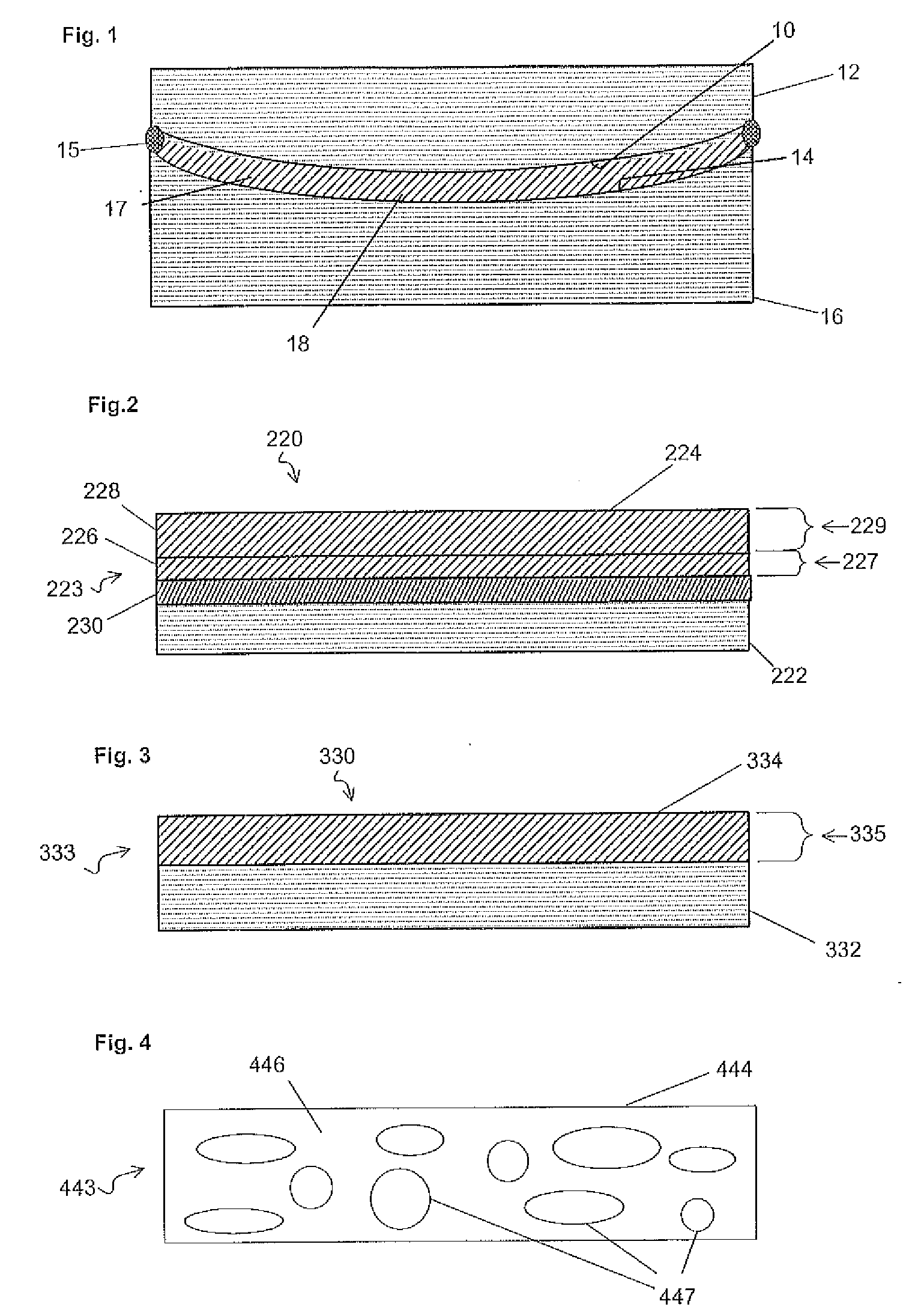Alignment facilities for optical dyes
a technology of alignment facilities and optical dyes, applied in the direction of instruments, polarising elements, transportation and packaging, etc., can solve the problems of changing the amount of space occupied by the compound, and the inability to achieve full alignmen
- Summary
- Abstract
- Description
- Claims
- Application Information
AI Technical Summary
Benefits of technology
Problems solved by technology
Method used
Image
Examples
examples
Polymerization Induced Phase Separation Examples
[0197]Liquid Crystal Monomers (LCM) 1-3 describe the preparation of the liquid crystal monomers used in the Examples. Photochromic / Dichroic (PC / DD) compound describes the preparation of PC / DD-1 used in the Examples. Photochromic Compound (PC) describes the preparation of PC-1 used in the Examples. Dichroic Dye (DD) describes DD-1 used in the Examples. Examples 1-7 and Comparative Example 1 (CE-1) describe the formulations containing the LCM prepared according to the method described with Table 2. Example 8 describes the preparation and testing of the samples coated with Examples 1-7 and CE-1.
[0198]The following abbreviations were used for the chemicals listed:
Al(OiPr)3—aluminum triisopropylate
DHP—3,4-dihydro-2H-pyran
DCC—dicyclohexylcarbodiimide
DMAP—4-dimethylaminopyridine
PPTS—pyridine p-toluenesulfonate
pTSA—p-toluenesulfonic acid
NMP—N-methylpyrrolidone
[0199]BHT—butylated hydroxytoluene
THF—tetrahyrdofuran
mCPBA—3-chloroperoxybenzoic acid...
examples 1-7
[0223]Examples 1-7 were prepared according to the formulation listed in Table 1 using the specific LCM, DD, PC / DD and PC listed in Table 2. Comparative Example (CE) 1 was prepared following the same procedure except that the weight percent of the Host LCM was 60 instead of 50 percent and there was no Guest LCM.
TABLE 1Weight Percent(based on the total weight of thesolution of the LCMs and theMaterialssolvent unless specified otherwise)Host LCMs50Guest LCMs10Solvent(1)40Initiator(2)1.5 based on LCM solidsStabilizer(3)0.1 based on LCM solidsDye when present (PC / DD, PC, or6.0 based on LCM solidscombination of PC / DD & DD)(1)Solvent was 99 weight percent anisole and 1 weight percent surfactant sold as BYK ®-346 additive by BYK Chemie, USA.(2)Initiator was IRGACURE ® 819, a photoinitiator that is available from Ciba-Geigy Corporation.(3)Stabilizer was 2-methyl hydroquinone.
TABLE 2GuestExample #Host LCMsLCMsDye1RM-257(4) / RM-105(5) / RM-23(6) / ZLI-1565PC / DD-1RM-82(7) (1:1:1:1)2RM-257(4) / RM-105(...
example 8
Preparation of Samples Coated with Examples 1-7 and CE-1
[0225]Each of the Examples and CE was used in the procedure described hereinafter in Parts A-E, to prepare at least partial coatings on the surface of a substrate. Prior to preparation, the phase transitions of each example were determined by the procedure described in Part F. The Absorption Ratios and optical response measurements are described in Part G.
Part A—Substrate Cleaning
[0226]Square substrates measuring 5.08 cm by 5.08 cm by 0.318 cm (2 inches by 2 inches by 0.125 inch) prepared from CR-39® monomer were obtained from Homalite, Inc., Wilmington, Del. Each substrate was cleaned by wiping with a tissue soaked with acetone and drying with a stream of nitrogen gas.
Part B—Alignment Layer Application
[0227]A solution of a photo-orientable polymer network available as Staralign® 2200 CP10 solution from Huntsman Advanced Materials, Basel, Switzerland, was diluted to 4 weight percent in cyclopentanone. The resulting solution was...
PUM
| Property | Measurement | Unit |
|---|---|---|
| thickness | aaaaa | aaaaa |
| thickness | aaaaa | aaaaa |
| thickness | aaaaa | aaaaa |
Abstract
Description
Claims
Application Information
 Login to View More
Login to View More - R&D
- Intellectual Property
- Life Sciences
- Materials
- Tech Scout
- Unparalleled Data Quality
- Higher Quality Content
- 60% Fewer Hallucinations
Browse by: Latest US Patents, China's latest patents, Technical Efficacy Thesaurus, Application Domain, Technology Topic, Popular Technical Reports.
© 2025 PatSnap. All rights reserved.Legal|Privacy policy|Modern Slavery Act Transparency Statement|Sitemap|About US| Contact US: help@patsnap.com



